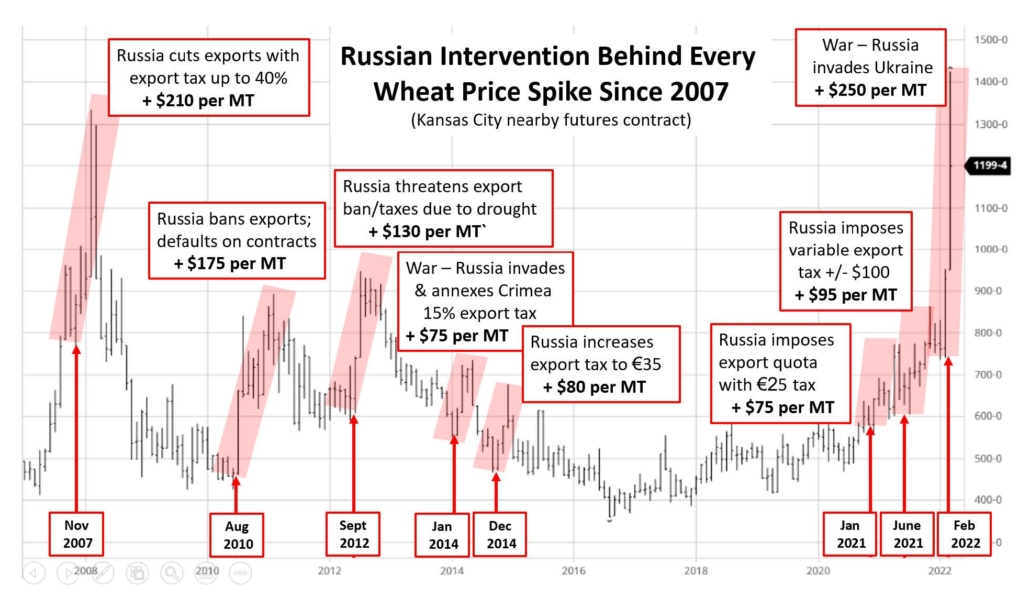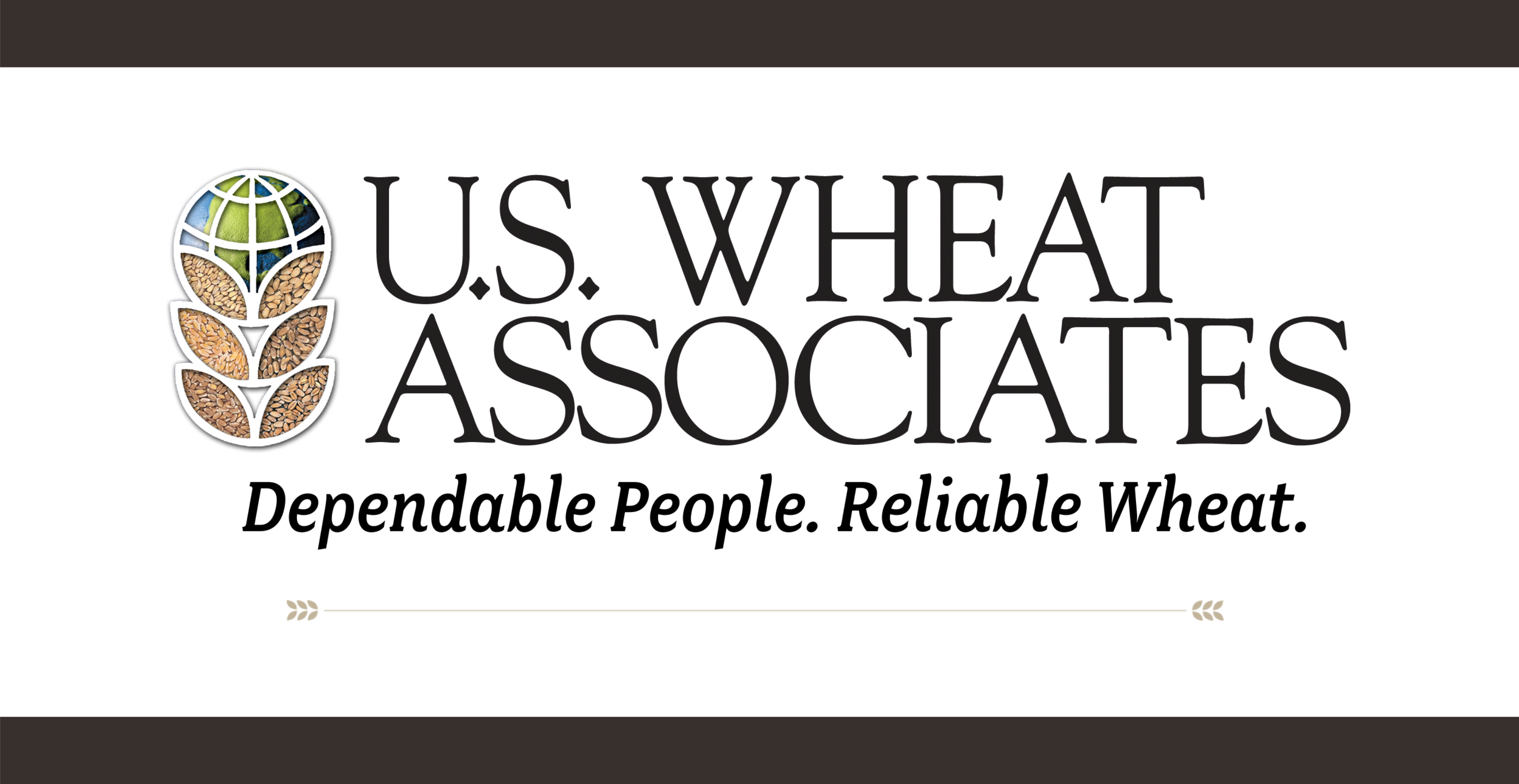Russian Intervention Has Fueled Every Wheat Price Spike Since 2007
Editor’s Note: On March 11, 2022, U.S. Wheat Associates (USW) President Vince Peterson commented on the Russian government’s role as a source of great uncertainty for the world’s wheat producers, sellers and buyers. One year later, the price disruption of Russia’s unprovoked invasion of Ukraine continues. While prices have settled since the invasion started, the market still moves on every scrap of news from the Black Sea region. Reprinted here are Mr. Peterson’s views then, providing perspective today.
Once again, and tragically this time, Russian intervention is the underlying source of dramatic global wheat price volatility.
“…We are closely monitoring prices for the most essential social goods such as food, including bread,” said Russian Prime Minister Mikhail Mishustin this week about its domestic wheat supply. “Russian grain is in good demand from abroad, and its price is increasing. That said, it is necessary to provide the necessary raw materials, first of all, to the domestic baking industry.”
This Al Jazeera English report provides important insight into the situation in Ukraine one year after the invasion ordered by President Putin.
Consistent Protectionism
The Prime Minister made this comment with specific reference to the hyper reaction of global wheat prices to Russia’s invasion of Ukraine and the immediate impacts of the widespread economic sanctions levied on Russia in response. Yet it spotlights the core tenants of Russia’s protectionist and heavy-handed wheat supply and price control policies. Russian intervention has been front and center since the country first entered the global wheat export trade.
Anyone who does not take the Prime Minister at his word on this sets themselves up for a very disappointing and expensive lesson. Defending Russian domestic supplies and keeping domestic prices low by withholding supplies from the world will always be their primary wheat policy weapon. And they deploy it without regard for the harm and expense it creates for anyone.
Underscoring this point, the Russian Ministry of Economy confirmed on Mar. 11, 2022, that they are banning wheat exports through Aug. 31, 2022, to their fellow Eurasian Economic Union member states, including its Ukraine invasion staging partner Belarus, along with Armenia, Kazakhstan and Kyrgyzstan.
Every Spike Reveals Russian Intervention
In six documented situations since 2007, when the global wheat market showed any sign of stress, the government of Russia stepped in to impose an export ban, export tax or export quota to isolate their home market. These actions intentionally limited world wheat importers’ access to Russian wheat supplies. This Russian intervention further magnified any supply shortage and accelerated the rise in wheat prices.
Twice in this time frame, Russian military aggression against Ukraine directly caused world wheat prices to spike sharply. The world is reeling viscerally and economically from the shock of that situation right now.

Correlations. Russian intervention is associated with the upward spike in hard red winter wheat futures prices. Factors include export restrictions, taxes, and, sadly, two invasions of its sovereign nation neighbor Ukraine. Copyright 2022 U.S. Wheat Associates.
Rampant Uncertainty
The COVID-19 pandemic lifted the tide of global inflation by disrupting global supply chains. Now, Russia’s war on Ukraine has blocked nearly 30% of the expected wheat export supply from governments and people that depend on it the most. Uncertainty runs rampant. And it is almost impossible to know how this war will be prosecuted. How long it will persist? What will the physical and economic situation of Ukraine and Russia be at the end?
Market analysts everywhere are trying to assess the many implications of this latest Russian intervention. Who will be most severely impacted? What will be the magnitude of the shortage created in the global wheat supply chain? And how will the world’s remaining supplies be apportioned, priced and relocated to the most severely affected countries?
Extreme Volatility
The extreme wheat price volatility seen in the past two weeks sits witness to this uncertainty.
Such high prices and volatility create challenges for the world’s wheat buyers and farmers and grain traders, who must also use the futures market to manage price risk. It is important to note that the U.S. wheat market remains fully open to importers and users everywhere. Dependable U.S. wheat producers and our reliable export system stand in the gap. They are ready and able to supply wheat as broadly to the world as our own supplies, and logistical capacity can accommodate.
Supplies Available
In addition to the wheat price inflation attributed to Russian intervention, U.S. wheat prices reflect that last year’s drought in the Northern Plains and Pacific Northwest limited current U.S. supplies. However, this year’s original export expectations and calculations do not include all U.S. supplies available. And wheat farmers will harvest a new crop starting in June.
U.S. Wheat Associates (USW) also creates additional value for U.S. wheat through the services it offers its customers. As they navigate this extreme market situation to secure the wheat necessary to feed people worldwide, USW remains ready to provide any information, tools and assistance within our means that may be helpful.
By USW President Vince Peterson


